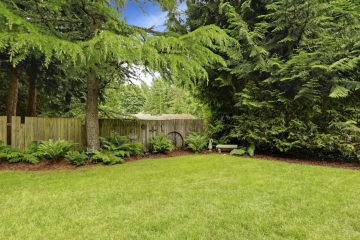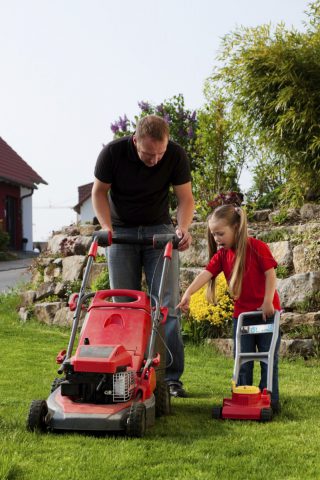Taking Care of Your Lawn Through the Seasons
Rolawn has compiled some tips on keeping your lawn healthy throughout the year. Follow their advice for an attractive garden in all seasons.
Spring
Rolawn says that spring is a “key season for maintaining your lawn.” This is when plants have their most energy, and thus lawns can recover from the winter period. If you put the time and effort in now, nature will assist you in generating beautiful results through the rest of the year.
Mowing
Rolawn suggests setting the mowing height quite high in early spring, “taking no more than one third of the length of the plant off at a time; otherwise the lawn will become stressed.”
They advise a little and often method in spring. As spring continues and the grass grows quicker, mowing can be increased, and the height gradually reduced.
Feeding
It is “essential” to feed your lawn during spring, says Rolawn. The grass is growing fast at this time, and they need the right nutrients, in the right quantities to grow strong and healthy. Healthy grass will result in a thicker, denser and greener garden.
Rolawn also says: “A combined fertiliser, weed and moss-killer will also ensure your lawn stays weed and moss free. Apply when the soil is moist and the grass leaves are dry, watering in well after a few days if necessary.”
Moss control
“If moss is a problem on your lawn, you will need to scarify it out,” explains Rolawn. You could also use a moss-killer before scarifying, however, in this case you should wait for it to turn brown/black before scarifying.
Weed grasses
Weed grasses are obvious to spot, as they are different to the rest of the lawn. Poa Annua is endemic in the northern hemisphere. Look out for seed heads forming from pale plants. Cutting the plant out and removing the roots can remove these. To avoid more Poa plants growing, you should fill the area in with a mixture of topdressing and lawn seed.
Topdressing
Topdressing retains a level surface, improves drainage, and controls the build-up of thatch. Rolawn suggest applying up to three litres (4kg) per metre2 and work into the grass with the back of a rake or brush.
Over-seeding
If your lawn has received some damage in previous months, early spring is a good time to over-seed the grass and fill any sparse patches. Topdressing and seed can be combined to save time.
Repairs
Badly worn areas can be patched with a few rolls of turf from your garden centre.
Summer
Mowing
As the temperature heats up, the growth of your lawn may actually slow down. You should mow as and when necessary, but don’t take off more than one third of the length in one cut. In dry conditions, lifting the mowing height will encourage deeper roots, reduce evaporation, and improve drought tolerance.
Feeding
Feeding your lawn in summer is dependent on weather and growth patterns. Applying fertiliser in late spring should provide sufficient nutrients for the grass through to autumn. A colder, wetter summer can cause nutrient drain, and further fertiliser applications could be required for a healthy lawn.
Watering
It is advised that you water at the first signs of drought; when the grass is still green, but shows signs of stress, such as little growth or a dulling in the normal bright green colour. Try to water evenly, and only at times when the water will soak in better, for example early morning or evening.
If your lawn is suffering from drought, you should mow as little as possible. Summer can cause the lawn to turn brown and straw-like. Good maintenance in other seasons can help your grass recover from periods of drought. Rolawn says: “Avoidance is better than cure and the only way to prevent drought is to water the lawn.”
Broadleaf weed treatment
Applying a suitable selective herbicide or all-in-one treatment, such as a lawn fertiliser or weed amp, should treat broadleaf weeds. Instead you could weed them out by hand, or use a knife/mechanical weeder.
Lawn pests
The most common lawn pests are Chafer Grubs and Leatherjackets, and can cause substantial damage to lawns. If you see areas of poorly growing, yellowing grass, check for grubs feeding on grass roots. Birds or badgers digging for grubs can also indicate that grubs are present. These can be easily and safely controlled, by using a suitable nematode-based product.
Autumn
Leaves and debris
Use a light rake or brush to keep the lawn free of any leaves falling from the trees.
Vegetation
Grass relies on light, the correct balance of heat, water, air, and food. Foliage, surrounding shrubs, and tress around the lawn should be cut back if possible, to reduce the competition for essential nutrients and water, and to avoid leaving parts of the lawn in constant shade.
Mowing
As the days are shorter and temperatures drop, the rate at which the grass grows will slow down, meaning that it will need to be mowed less often. Rolawn says: “It is also a good idea to raise the height of cut as winter approaches.”
Scarification
Scarification can be done using a spring-tine rake, by forcefully pulling the rake through the turf. Electric or petrol scarifiers are also available to hire from garden centres or DIY stores. Rolawn explains: “Scarification reduces the build-up of dead grass matter, roots and moss which can cause increased stress to the grass plants.”
Feeding
Feeding in autumn will supply the lawn with essential nutrients to strengthen it in the winter. Rolawn advises: “As autumn progresses, damp conditions can lead to diseases such as fusarium patch. Applying an autumn lawn food in early autumn will help combat these by strengthening the grass plants as well as giving your lawn an attractive green colour.”
Aeration
“Aerate consolidated areas of the lawn to relieve compaction, improve drainage and allow more air into the root system,” says Rolawn. “Use a fork to spike the lawn 25-50mm apart.”1 For large lawns, garden centres and DIY stores hire out aerating machines.
Winter
Rest the lawn
Rolawn advises to rest the lawn as much as possible in winter. They say to stay off the grass when it is wet or frosty, as the grass plants are not actively growing and will not repair themselves until spring.
Mowing
Only mow your lawn when absolutely necessary. This will depend on the weather and temperature at the time. Avoid mowing if heavy frosts are expected or when the ground is very wet.
Worms
Worms improve the nutrient content of soil and benefit soil structure. Worm casts are best left to dry and swept away with an outdoor brush.
Preparing for spring
Wintertime is a good opportunity to get ready for the warmer seasons. You can be proactive by: servicing your mower, tidying the shed, sharpening edging shears, and organising for spring.
1 http://www.rolawn.co.uk/seasonal-lawn-care-guide/

